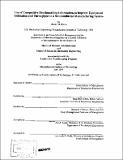Use of competitive benchmarking information to improve equipment utilization and throughput in a semiconductor manufacturing system
Author(s)
Bhatia, Manish Hasso
DownloadFull printable version (2.630Mb)
Advisor
Jung-Hoon Chun and Robert S. Gibbons.
Terms of use
Metadata
Show full item recordAbstract
The use of contract manufacturers is becoming more common in the semiconductor industry. These foundries. as they are known in the industry, focus their efforts on achieving operational excellence in order to manufacture semiconductor products more cost effectively than their customers can internally. Intel has started using Foundries for non-microprocessor products in order to help them reserve internal production capacity for their microprocessors. A side benefit of the outsourcing process for Intel, is the opportunity to benchmark their own operational efficiency against that of their supplier. This thesis will discuss the process used for this benchmark study, its results and managerial implications of the findings. A benchmarking problem statement was defined including a rationale for focussing on the lithography area as the highest leverage point in the operation, and a description of the wafer throughput metric that was used for the comparison. The raw results of this study show a 33% deficit for Intel compared with Supplier X in lithography throughput. These data, however, included effects of both different machine type!i and different operational practices. Because Intel has strategic reasons for selecting its equipment vendors, the focus of this study was not to suggest that they switch lithography equipment vendors. Rather, the goal was to understand how much of this deficit could be attributed to Supplier X's superior operational practices. In order to remove the convolving effects of different equipment run rates, a set of experiments was performed to separate machine effects from operational effects allowing for a direct comparison operational efficiencies. These experiments showed that Intel has a 15% deficit in lithography throughput when compared with Supplier X, after normalizing for equipment effects. Reasons for this deficit could include Intel's excessive use of testing procedures, Intel's risk averse operational culture and Intel's possible managerial hubris.
Description
Thesis (M.B.A.)--Massachusetts Institute of Technology, Sloan School of Management; and, (S.M.)--Massachusetts Institute of Technology, Dept. of Mechanical Engineering, 1999. Includes bibliographical references (leaf 45).
Date issued
1999Department
Massachusetts Institute of Technology. Department of Mechanical Engineering; Sloan School of ManagementPublisher
Massachusetts Institute of Technology
Keywords
Sloan School of Management, Mechanical Engineering